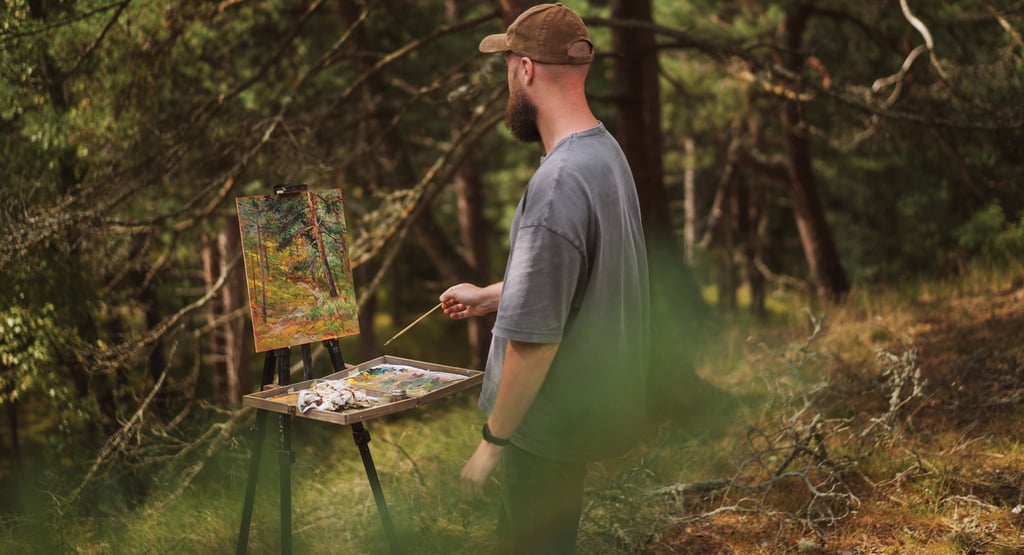What is plein air painting?
Painting tips


Kartais gaunu asmeninių žinučių feisbuke ar instagrame su klausimais apie paveikslų tapybą gamtoje, todėl nusprendžiau atsakyti čia visiems kartu.
Paprastai, mano nuomone, nedideliam paveikslui gamtoje skiriu apie 2-3 valandas. (O jei kas nežino – tapyba gamtoje reiškia tapymą lauke, tiesiai vietoje. Esi gamtoje, mieste ar kur nors kitur ir tapo tai, ką realiai matai prieš akis. Manau, tai žiauru, sudėtinga, bet labai apmokama. Varžaisi su šviesa, kovoji su oru, vabzdžiais, vėju – bet, aš taip galvoju, tai ir yra to grožis.) Kartais nusivedu paveikslą į studiją pabaigti – pataisau šešėlius, kraštelius ar pridedame detalių – bet didžioji dalis darbo daroma vietoje. Visaip būna, žinoma.
Jei nori tapti geresniu, manau, reikia praktikuotis – daug. Su kiekvienu paveikslu stengiuosi ištaisyti tai, ką sušikau paskutinį kartą – kam nepasitaiko tokių momentų? Būk sąžiningas su savimi ir visada ieškok būdų tobulėti. Aš taip galvoju – sutelk dėmesį į piešimą. Piešk gerai. Tikrai gerai. Suprask, kaip dalykus suskaidyti į 2D figūras, bet taip pat kaip tas figūras paversti tikėtinomis 3D formomis. Mokykis perspektyvos. Mano nuomone, tai ne pasirinkimas – tai gero tapymo pagrindas.
Laikyk paletę paprastą. Rimtai. Tikriausiai nereikia visų spalvų iš meno parduotuvės. Užtenka baltos, šilto ir šalto geltono, šilto ir šalto raudono, šilto ir šalto mėlyno – ar net tiesiog baltos, geltonos, raudonos ir mėlynos. Išmok jas valdyti. Manau, daugiau išmoksi apie spalvas jas maišydamas pats nei pasikliaujant gatavais atspalviais.
Pradėk nuo mažų darbų. Tapo 15x20 cm, 20x25 cm formatais, greitais eskizais. Aš taip galvoju – tau reikia patirties, o ne šedevrų. Kiekis veda į kokybę – patys suprantat.
Užbaik savo paveikslus. Net jei nekenčiši jų per pusę. Net jei prireiks savaičių ar mėnesių juos tobulinti studijoje. Visaip būna, bet užbaigimas išmoko daugiau nei metimas. Tai verčia spręsti problemas ir galvoti apie visą paveikslą kaip visumą.
Pamiršk nuotraukas kuriam laikui. Jos meluoja, mano nuomone. Jos viską išlygina ir užmuša subtilius šešėlių skirtumus. Vietoj to žiūrėk į meno istorijos tapytojus. Studijuok jų darbus. Kopijuok. Stengiuos suprasti, kaip jie tvarkėsi su šviesa, kraštais, teptuko smūgiais ir spalvomis. Mokykis iš žmonių, kurie visą gyvenimą sprendė šiuos dalykus – tikriausiai žino, ką daro.
O kadangi tapyba gamtoje turi savo specifikos, štai keletas papildomų patarimų:
Iš anksto apžiūrėk vietas. Gera šviesa netrunka ilgai, todėl verta žinoti, kur nori būti, kai ji atsiranda – patys suprantat.
Supaprastink vaizdą. Nebandyk tapyti kiekvieno lapo ar lango – žiūrėk prisimerkęs, sumažink ir pirma sugauk didžiąsias formas ir šešėlius.
Dirk greitai ir ryžtingai. Šviesa nuolat keičiasi – kam nepasitaiko tokių momentų? Priimk drąsius sprendimus ir koreguok eigoje.
Naudok rėmelį kompozicijai. Manau, jis padeda suformuoti kompoziciją ir ignoruoti vizualų chaosą.
Pasiimk tinkamą įrangą. Lengvą molbertą, ribotą paletę, servetėles, vabzdžių repelentą, kepurę nuo saulės ir segtukus nuo vėjo. Neprisikrauk per daug – visaip būna, bet geriau mažiau nei per daug.
Žinok orų prognozę. Debesys, vėjas ir šviesa gali greitai keistis. Būk pasiruošęs ir lankstus – aš taip galvoju.
Užsirašyk pastabas. Parašyk, ką bandei užfiksuoti – spalvą, nuotaiką, paros laiką. Tikriausiai tai padės, jei vėliau tobulini darbą.
Nevaikyk šviesos. Anksti užfiksuok šviesos schemą ir jos laikykis, net jei scena keičiasi tau tapant – patys suprantat, kaip sunku kartais.
Smagiai. Mano nuomone, tai ne apie šedevro kūrimą kiekvieną kartą – tai apie mokymąsi matyti ir tapimą geresniu tapytoju, po vieną teptuko potėpį. Visaip būna, bet svarbiausia – nepasiduoti.
